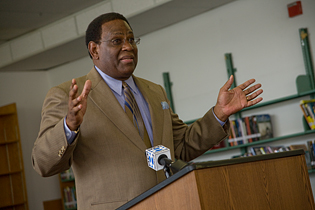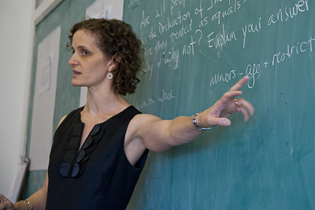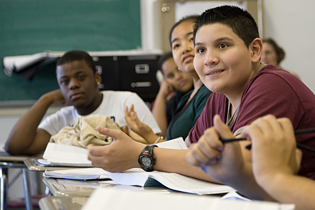At the beginning of the debate, Apple Pham was on the losing side. But by speaking from personal experience, the ninth-grader convinced her classmates that ethnicity sometimes has little to do with how you look.
The debate took place this week at New Haven Academy. It put on display not only some of the complex racial dynamics that kids and adults alike find it hard to discuss in America. It also showed how one school is teaching kids to think for themselves and argue for what they believe — prerequisites for active citizenship in a democracy.
In that sense, Hang “Apple” Pham served as a model student as she debated her classmates.
Students in Apple’s class took up the question of whether a person is justified in trying to change the race listed on her birth certificate if it’s not the race with which she identifies.
As students argued over what makes a person white or black, Apple argued that your race is determined by your ancestry, not by the way you look. She said even though everyone thinks she’s Puerto Rican, she’s not. She was not born in the U.S. and identifies herself as Vietnamese and African-American.
Click play above to see excerpts from the debate.
The class discussion was part of an open house day on Wednesday at New Haven Academy. The interdistrict magnet high school has just moved its 240 students into its a home in the old Co-Op High School and St. Mary’s building on Orange Street.
At 11:30 a.m. parents and neighbors gathered in the school’s library to hear school founders Greg Baldwin and Meredith Gavrin speak about their vision. New Haven Academy (NHA) has “a twofold mission,” Gavrin said: to prepare students for success in college and to have them “ready to be active citizens in a democracy.”
To that end, NHA emphasizes hands-on learning and critical thinking. That means exploring an issue through discussion and then being able to defend your opinion. Students are encouraged to cultivate five “Habits of Mind” that train them to question what they know and how they know it.
 Reggie Mayo, New Haven’s superintendent of schools, praised the NHA teaching methods. The school prepares students for life, he said. “They have to defend their positions. That’s what life is about.”
Reggie Mayo, New Haven’s superintendent of schools, praised the NHA teaching methods. The school prepares students for life, he said. “They have to defend their positions. That’s what life is about.”
That’s what Gavrin’s 11:40 a.m. class was about.
 Following her speech in the library, Gavrin (pictured) went to room 205 to teach Apple and her classmates in one of the two weekly periods of a curriculum called Facing History And Ourselves. The program, which is a required class for all freshman, asks students to grapple with race, identity, and discrimination by looking at the history of events like genocide.
Following her speech in the library, Gavrin (pictured) went to room 205 to teach Apple and her classmates in one of the two weekly periods of a curriculum called Facing History And Ourselves. The program, which is a required class for all freshman, asks students to grapple with race, identity, and discrimination by looking at the history of events like genocide.
Visitors were invited to sit in on the 80-minute class, in which students discussed the history of eugenics science in the U.S. and argued about what it means to be white or black.
The culmination of the period was a classwide debate about a 1977 incident in Louisiana, in which a New Orleans woman named Susie Guillory Phipps discovered at 43 years old that her birth certificate listed her as “colored.”
Although Phipps considered herself white, the state traced her family tree back 222 years and discovered that her great-great-great-great-grandmother had been black. Without the 97 percent white ancestry required to be “white” in the eyes of the state, Phipps was listed as “colored.”
Phipps spent $20,000 trying to have her birth certificate changed to say “white.” She wasn’t successful, but Louisiana repealed its 97 percent law just a few years later, in 1983.
The question for Apple’s class on Wednesday: Was Phipps justified in asking Louisiana to change it?
 Most of the class thought she was. Apple didn’t agree. Neither did Eddy Cordova (pictured) or Jonandrew Ochoa. The three students faced off across the classroom against 11 other classmates.
Most of the class thought she was. Apple didn’t agree. Neither did Eddy Cordova (pictured) or Jonandrew Ochoa. The three students faced off across the classroom against 11 other classmates.
It was a “forced choice” debate, Gavrin explained. If the other side convinces you they are right, you can walk across the room and join them, but you can’t stay neutral.
As the debate began, Aaryn Russell supported Phipps’ right to try to change her birth certificate to say “white.” “If one member — one single member — of her family was black, and everyone else was white, then she’s white,” Aaryn said.
“She decided to waste $20,000 to change her [race]?” said Eddy. “That’s like being racist, because if she put that much money in it, she must not have liked the race for some reason.”
Apple responded directly to Aaryn’s comments.
“When you say it like that, it seems like you’re saying that she had a right to kind of like not accept her great — however many greats — grandmother as her ancestor because she wasn’t white,” she said. “I don’t see why she has to go through so much trouble, because it seems like she doesn’t accept that part of her, when it is a part of her.”
Alondra Arguello disagreed with Eddy’s assessment of Phipps. “I don’t think she was being racist,” Alondra said.
“OK, she had a great grandmother who was black, but right now, she’s white. And everyone she knows is white, so she is white. So she had a right to go and change [the birth certificate].”
After a few more exchanges, Apple and her debate partners had convinced several of their classmates to switch positions and join them on the their side of the classroom.
Apple disagreed with Alondra’s argument that Phipps was white because she looks white. “People say that I’m Puerto Rican, but I have no Puerto Rican in me,” she said. “That doesn’t mean that I should be Puerto Rican because that’s the way people saw me.”
Shortly thereafter, Unique Johnson switched over to Apple’s side, making the class evenly split as the class came to an end.
After the bell rang, Gavrin said Wednesday’s class was “pretty typical.” The curriculum gives students the tools to discuss complicated issues like race and identity and asks them to think critically about their choices, she said.
She explained why her school places such an emphasis on the Facing History And Ourselves curriculum. As an interdistrict magnet school, NHA combines students from a variety of backgrounds. You can’t put them all together without giving them the tools to talk about the differences, Gavrin said. “You don’t just do that. They have to be comfortable talking about race and class.” That’s what Facing History is designed to do.
The curriculum is also important because it looks at the repercussions of individual choices, Gavrin said. This speaks to the NHA themes of informed citizenship, critical thinking, and personal responsibility. When students study the Holocaust, for example, it is interpreted by examining not just the choices of people in power, but of everyone involved, Gavrin explained.
While looking at historical events through this lens, students are asked to consider the modern world and their place in it. “That’s the ‘And Ourselves’ part,” Gavrin said. “It’s ‘Alright, what’s going on around us?’”
By working on problems like “deconstructing what race is and isn’t,” Facing History teaches students to examine notions that others take for granted, Gavrin said.












A first step toward racial equality would be to stop classifying people. What is the purpose of identifying someones race on a birth certificate?